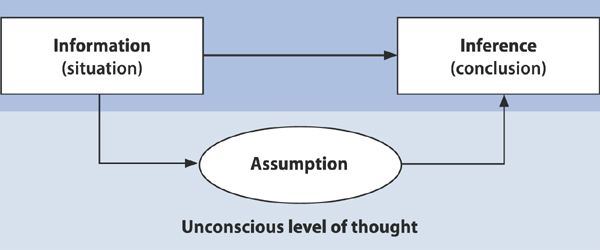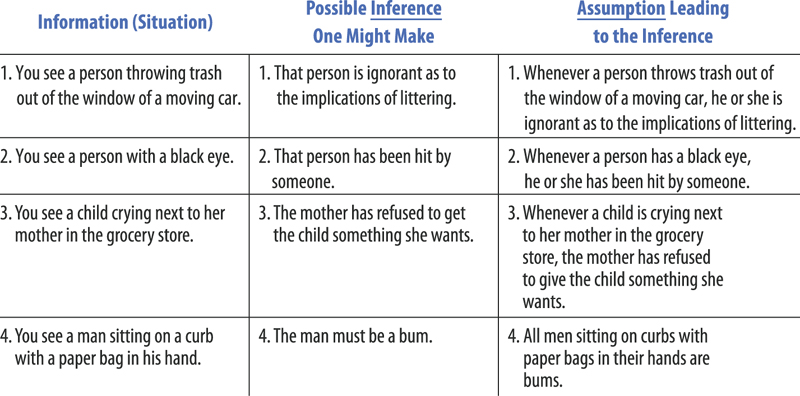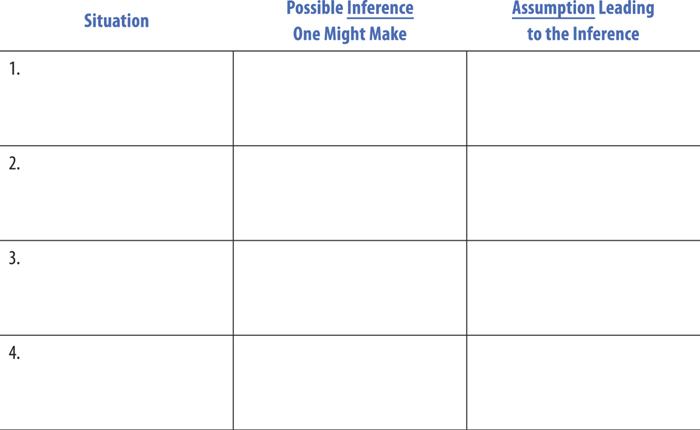Day Twelve. Distinguish Inferences from Assumptions
People often confuse inferences with assumptions. But it is important to clearly distinguish between these two elements or parts of reasoning. An inference is a step of the mind, in which the mind says, “This is true; therefore, that is true.” The conclusion, or inference, that something is true is based on something else being true, or appearing true. People routinely make inferences throughout the day. And these inferences can be justified or unjustified. All inferences are based on assumptions—that is, beliefs we take for granted. Justifiable assumptions lead to reasonable inferences. Assumptions usually operate at the unconscious level. When we uncover our assumptions, we often find the roots of prejudice, stereotyping, bias, and other forms of irrational thinking.
“A wise man proportions his belief to the evidence.”
—David Hume

Consider these examples focused on distinguishing inferences from assumptions:
Example 1:
Situation: My nation is in a conflict with another nation.
Inference: My nation is justified in this conflict.
Assumption: My nation is always justified in its conflicts with other nations.
Example 2:
Situation: My spouse spends considerable time with her male supervisor outside of work.
Inference: She is having an affair with her supervisor.
Assumption: Whenever a woman spends considerable time with her male supervisor outside of work, she is having an affair with him.
The following method (outlined in Table 12.1) identifies inferences and assumptions in your thinking. First determine what you might infer (either rationally or irrationally) in a situation. Then determine the specific generalization, or belief, that leads to the inference. This is the assumption.

When you explicitly identify inferences, and then figure out the assumptions leading to those these inferences, you gain more control over your thinking and therefore your life. You begin to uncover the assumptions, the beliefs you take for granted, that are guiding your actions. If, for instance, you assume that all supervisors are arbitrary, controlling people, this is what you will see in every supervisor you have. If you take for granted that the industrial pollution caused by your company doesn’t cause health problems, you won’t be motivated to check this assumption to see if it is justified, given the evidence. If you assume your spouse will always be there for you no matter how badly you treat him or her, you might be in for a surprise later on.
People often say, “I assume X is true, or I assume X,” when what they actually mean is “I infer X is true,” or “I infer X.” If they assumed it, they probably wouldn’t state it; they would take it for granted and therefore wouldn’t think it needs to be stated. They would likely think that others shared their view as well (and therefore, would not check their assumptions with those other people). Remember that assumptions usually lie at the unconscious level of thought and are therefore not always easily accessible.
Be on the lookout for...
...people confusing inferences with assumptions. Also notice how often people seem unaware of their inferences and assumptions. Notice when you use the word “assumptions” or “assume.” Notice when others use these words. Notice when you use the term “inferences” or “infer.” Figure out whether you, or others, are using these terms correctly.8 Work on ferreting out your assumptions by first noticing your inferences.
8. See inference and assumption in the glossary of terms.
Strategies for taking command of your inferences and assumptions
• To practice distinguishing inferences from assumptions, create your own situations. Then, formulate an inference someone might make, either justifiably or not, in that situation (X is true; therefore, Y is true). Finally, determine the precise assumption that leads to the inference.

• Practice distinguishing inferences from assumptions throughout the day, just to get the basic strategy down. Use a strategy like the one above. Begin to notice, first your inferences, and second your assumptions, in this way: “Right now, in this situation, I am inferring X; I am pretty sure this inference comes from this assumption...” Don’t be concerned with how profound or superficial your inferences and assumptions seem. Just work toward understanding this process as it is occurring in your mind: situation, then inference, and then assumption.
(situation → inference → assumption)
Note that though the assumption leads to the inference, to identify it, we approach it backwards. We look for the inference first because it lies more readily at the conscious level of thought. Hence, it is easier to identify it.
• When you have mastered this basic strategy, target the important inferences you make. What important inferences are you making about your career, your marriage, a big issue at work, your parenting, other sentient creatures, the prison system, capitalism, and so on.
